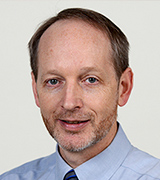David Holdsworth

Scientist
Why I Became a Scientist
Most scientists are motivated by innate curiosity about the natural world, and I am no different in that regard. Since I was quite young, I have enjoyed taking things apart to understand how they worked; surprisingly, some of those household items even remained functional when reassembled! This activity eventually grew into an interest in designing and building useful tools and devices, which can be applied in scientific research programs. After an undergraduate education in Physics and Biology, I completed an M.Sc. degree in Astronomy, before settling on a career in Medical Biophysics. I now enjoy opportunities to develop original and complex machines and imaging systems, which will help us to look inside humans and small animals, to answer important questions about health and disease. I am particularly interested in improving the tools that are available to investigate diseases of bones and joints.
Research Summary
Dr. David Holdsworth is a Scientist in the Imaging group at the Robarts Research Institute. He is also a Professor in the Departments of Surgery and Medical Biophysics in the Schulich School of Medicine and Dentistry, at the University of Western Ontario. For most of the past 15 years, Dr. Holdsworth has been involved in the development of vascular imaging systems, for use in stroke diagnosis and therapy. In 2007 Dr. Holdsworth became the Dr. Sandy Kirkley Chair in Musculoskeletal Research and has shifted the focus of his research to musculoskeletal disease, with projects ranging from basic skeletal research to clinical therapy. Dr. Holdsworth and his team have developed new methods for musculoskeletal disease detection and treatment for both basic pre-clinical and clinical applications. With collaborators in surgery and engineering, he is developing new techniques to image the interface between bones and metal implants, and to improve techniques for radiostereometric analysis following joint replacement.
Research Questions
How can currently available imaging systems be used to characterize dynamic joint motion?
The most important attribute of our joints is their ability to move easily into new positions, allowing us to remain mobile, do our jobs, and enjoy our leisure time. Our joints move in complex patterns, and to understand normal and diseased joints we must be able to study them in motion. For this reason, one of the goals of our program is to develop new techniques that will allow us to routinely characterize joint motion, in the arms and legs. If we can do this reliably, it will be a great help in the development of treatments to prevent failure.
How do biomechanical loading patterns influence joint failure, and also increase wear in joint replacements?
Musculoskeletal diseases, like osteoarthritis, lead to joint failure and loss of mobility for thousands of Canadians each year. One aspect of arthritis has become clear: it is directly related to the loads placed on a joint. Unfortunately, we still do not know what specific loading patterns are harmful, and which are actually helpful. For example, a football injury is harmful, but exercise in general will improve joint health. One way in which imaging can help to answer these questions is by combining detailed joint images with complex computer modeling, to produce numerical maps of loading patterns in moving joints.
Can measurements of velocity fluctuations in human vessels be used to determine stroke risk in patients?
In the area of cardiovascular disease, our group is interested in the development of techniques to assess the risk that vessel disease may lead to stroke. A large fraction of stroke injuries are a result of previous atherosclerotic disease in the neck vessels that supply the brain. Unfortunately, it can be difficult to tell in advance who is most likely to have a stroke, so that they can receive preventative surgery. One tool that we are developing relies on a modification to the ultrasound technique that is currently used in hospitals, allowing us to measure rapid fluctuations in blood velocity.
Education
- B.Sc., Honours Physics, University of Toronto (1982)
- M.Sc., Astronomy, University of Toronto (1986)
- Ph.D., Medical Biophysics, University of Toronto (1992)
Training
- Post-Doctoral Fellow, Robarts Research Institute (1992-1993)
Awards
- Research Scholarship, Heart and Stroke Foundation of Ontario (1997-2002)
- Premier’s Research Excellence Award, Province of Ontario (1999-2004)
- Career Investigator, Heart and Stroke Foundation of Ontario (2002-2007)
- Dr. Sandy Kirkley Chair in Musculoskeletal Research (2007)
Publications
Contact Info
Robarts Research Institute
Room 1254C, 1151 Richmond Street North
London, ON N6A 5B7
Phone: 519-931-5777 ext. 24154
Fax: 519-931-5713
Email: david.holdsworth@robarts.ca








